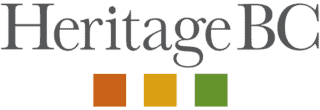- Heritage 101
- Advocacy
- Accessibility for Historic Places
- Climate & Sustainability
- Cultural Maps
- Heritage Place Conservation
- Heritage Policy & Legislation
- Homeowners
- Intangible Cultural Heritage
- Reconciliation
- Indigenous Cultural Heritage
- Setting the Bar: A Reconciliation Guide for Heritage
- 1. Heritage and Reconciliation Pledge
- 2. Acknowledging Land and People
- 3. Celebrating Days of Recognition and Commemoration
- 4. With a Commitment to Learn
- 5. Committing to Strategic Organizational Diversity
- 6. Mission-Making Room for Reconciliation
- 7. Possession, Interpretation, Repatriation and Cultural Care
- 8. Shared Decision Making
- 9. Statements of Significance and other heritage planning documents
- 10. Heritage Conservation Tools, Local Government Act
- Racism: Do Not Let the Forgetting Prevail
- Taking Action: resources for diversity and inclusion
- Webinars On-Demand
Community Heritage Commissions: Terms of Reference
 Every community heritage commission should have terms of reference (ToR) that set out working arrangements and other critical information, such as the commission’s purpose, chair and membership, meeting requirements, level of administrative support, and governance structure.
Every community heritage commission should have terms of reference (ToR) that set out working arrangements and other critical information, such as the commission’s purpose, chair and membership, meeting requirements, level of administrative support, and governance structure.
The importance of the terms of reference should not be underestimated. A well-conceived document will touch on all aspects of a commission and will be regularly consulted as the commission develops annual work plans and activities. Local governments, the community and the commission itself will be best served with a thorough description and complete understanding of the CHC’s roles and responsibilities.
Broadly, an effective ToR will:
- Clearly describe the purpose, structure and operating systems
- Define the roles and accountabilities of the members and describe their work and activities
- Be collaboratively developed and reviewed
- Be easy to read and understand.
It is important to note that the bylaw that creates the heritage commission must be clear on a number of items:
- The terms of reference for the commission must be specifically identified.
- The number and types of members, with guidance on the type of expertise sought within the membership.
- The process by which members are appointed by the municipal council or regional board.
- The procedures regarding the conduct of members, their responsibilities as commission members, and the governing procedures for meetings.
In some cases, the ToR is contained wholly in the bylaw (City of New Westminster) and in other cases the complete ToR are contained in a separate document (District of Mission).
Vision, Mission, Goals, and Objectives
By describing the commission’s mission, goals, and purposes, the ToR will outline the CHC’s work and value.
The purpose of the commission should be unambiguous, and the ToR should be written with sufficient thoughtfulness and clarity so that it focusses and guides the CHC’s work.
- A vision statement is an idealistic and aspirational statement that imagines a future condition as a result of the CHC’s successful accomplishments.
- The City of Richmond will be “the most appealing, livable, and well-managed community in Canada.”
- A mission statement will answer the questions: What should happen as a result of the work of the commission, and how will the community be changed?
- Prince George Heritage Commission will serve “to protect, conserve and interpret the heritage resources within the City by supporting, encouraging, and facilitating their proper conservation, maintenance and restoration.”
- Goals will broadly explain what will be achieved.
- Objectives are more detailed, measurable and time-specific. Objectives are the necessary steps to achieve the goals, which in turn achieve the mission.
Authority and Accountability
The ToR should outline the authority and parameters related to the CHC’s ability to make decisions and recommendations, as well as to undertake actions.
Reporting requirements will describe who will receive information, in what timeframe, and in what form (e.g. minutes, studies, reports). The reporting relationship to council should be clearly defined.
The ToR may also include information about such actions as hiring a consultant, developing a website, coordinating events, and so on.
Overall, authorities and accountabilities will clarify relationships and communication requirements.
Membership
The ToR will detail the exact make-up and mix of members, which can be drawn from the community-at-large, government staff, and politicians. The details about member qualifications can include geographic representations, which may be particularly important for a regional district, and organization affiliations, as well as professional expertise.
The City of Vancouver requires that every individual appointed to the Commission must:
- be an elector of the City; or
- have been a resident of the Greater Vancouver Regional District for not less than six consecutive months immediately preceding his or her appointment;
- not be a member of the Council of the City;
- not be an employee of the City
In addition to the general public, the CHC may include representatives from the library and education systems, representatives of local history and heritage organizations, liaison with the Chamber of Commerce, as well as municipal planners, professionals, and individuals with specific skills, such as archaeologists, landscapers, builders, etc.
The ToR will include a minimum and maximum number of members, specifying which numbers have voting privileges and which do not. Additionally, the length and number of terms for the members should be clearly described.
The size of the membership should take into account the size of the community and the expected work of the heritage commission. A heritage commission that is too small may not be able to successfully meet the needs of the local government and the community.
Example from Bowen Island Heritage Commission:
The Commission shall be composed of seven (7) voting members. Voting Members:
- One (1) Councillor
- Up to three (3) representatives of the Bowen Island Heritage Preservation Association
- Up to three (3) representatives(s) of the Bowen Island Museum and Archives
- Up to three (3) representatives(s) of the community at large with the following interests and knowledge:
- Local Heritage conservation;
- Architecture, planning and design;
- Building construction;
- Landscape architecture and horticulture;
- History;
- Business and tourism; and
- Nature conservation
- When appointing members, Council must consider the interests, skills and experience necessary to carry out the Commission’s mandate.
Example from Kitimat-Stikine Heritage Advisory Commission:
- Each voting member of the Commission shall be appointed for a period of 2 (two) years commencing January 1 of the year of their appointment and terminating December 30 two years hence. For the first year, Commission members should be appointed in October, 2007.
- The maximum length of service for voting members to the Heritage Advisory Commission shall be 6 (six) consecutive years.
Governance
The ToR will describe CHC’s governance structure, including:
- Eligibility criteria and term length of the chair
- Information about the role of secretary
- Recruitment and election/appointment criteria
- Approval method of appointees
- Meeting schedule or minimum number of meetings per cycle; (see Timeframe (following) for more information)
- Information about the preparation for and calling of meetings, minute taking, and quorum
- The expectation for attendance of general public
- Compensation and reimbursement expectations. Members are not typically compensated for their time and services, but it is appropriate to offer reimbursements for actual expenses. However, authorization should first be required before expenses are incurred.
Timeframe
The ToR should describe when the CHC will start its work, how frequently it will meet (or at least the minimum number of times it will meet in a given period), and the expected time requirements for the commission members.
The ToR will state the length of a term and the number of terms a member may serve. For example, a CHC member may be appointed for up to three 2-year terms and therefore sit on the commission for a maximum of six years.
Best practices include:
- A description of meeting expectations for members. Typically, this will suggest that, if a member misses a specified number of consecutive meetings or a specified number of meetings in a given period, the member’s appointment may be reconsidered. This information is critical when addressing chronic absenteeism.
If a member misses 3 consecutive meetings, or has 4 or more absences within a year without giving reasonable notice, the Chairperson will contact that member to discuss the situation. The Chairperson may request the resignation of the member. Mission Heritage Commission
- A limitation on the number of consecutive terms. It may be possible for a member to be re-appointed after an absence, but it is desirable to encourage renewal and to gain access to new ideas and energies. If a member is allowed to return to the CHC, the ToR should specify the minimum period of absence (often a minimum of one term). Commissions that do not renew and refresh its membership can run into issues of controlling members and compromised succession planning.
- Staggered terms so that the CHC does not lose too many members at one time. If members sit for two-year terms, then ideally 50% of the members will retire or be renewed each year.
It also may be desirable to involve former members in non-voting roles that allow them to support the continued work of the heritage commission.
Other inclusions:
- Outline available resources, such as staff support, expenses/budget, and equipment. Costs may include projects, public education and awareness activities, printing and promotions, awards events, and other planned activities.
- Description of linkages to other commissions, committees, departments, organizations, and events.
- Appointment, role and contributions of municipal staff.
- Evaluation format that will measure the effectiveness of the heritage commission’s work. Measurements can be used to make adjustments to improve effectiveness and output.
- Procedure to fill commission vacancies and to receive delegations.
